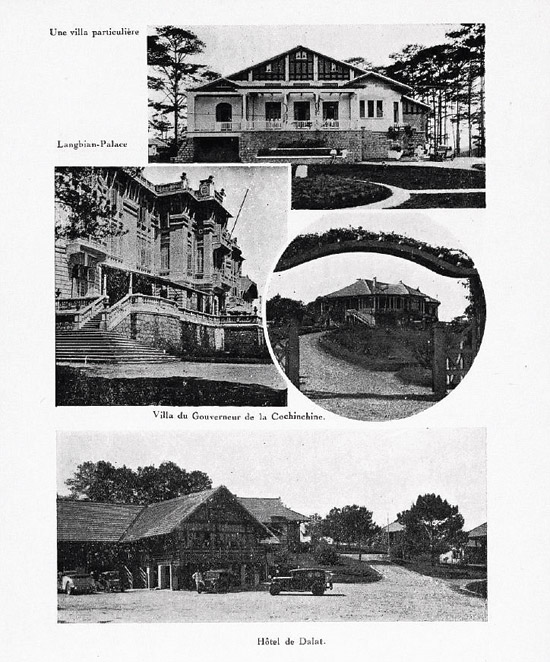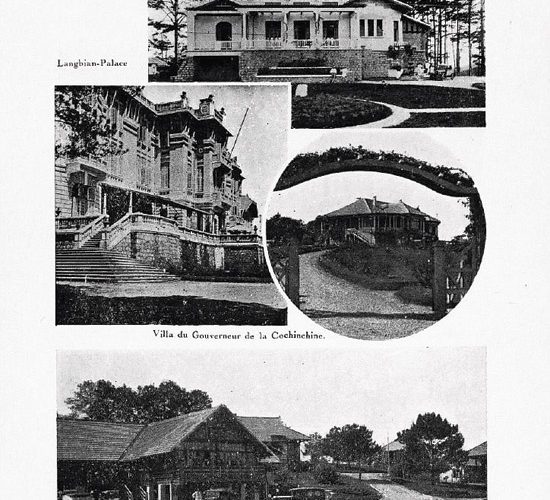(No.11, Vol.3, Dec 2013 Vietnam Heritage Magazine)
At the end of the nineteenth-century, Dalat was still a deserted place without a single Vietnamese person. The
founding of Dalat owed itself to the initiative of the French. In a report for the Governor-General, Resident Mayor A. Berjoan stated, ‘Dalat occupies a special favorable position in the Far East. Dalat’s climate, scenic landscape, and capacity for expansion make it an advantageous place with which no other can compare… Dalat can and must become a recreational site in the Far East’s immense mountain region.’
Just as the Americans founded Banguio (1,800m) in the Philippines, the British Ootacamund (2,200m) in South India, and the Dutch Tosari in Java, the French established the city of Dalat at an altitude of 1,500m, chiefly so that colonial administrative officials could go up there for rest and recreation rather than take leave back in their motherland.
Dalat truly had the conditions to become Southeast Asia’s major vacation centre. It lay on the expansive Langbian Plateau. The city had readily traversable roads, a cool, crisp climate, and fertile soil, sufficient humidity and abundant rain that provided enough for fresh trees and profuse organisms. By air, Dalat is about 250km from Saigon and no more than 100km from towns and critical ports, especially Cam Ranh, on the coast of the East Sea.
Dalat can be seen as having had gone through the following stages:
Stage 1 — During the period when it was discovered by the French (1893-1899): This was from the time that Dalat was discovered by doctor Yersin until Governor-General P. Dourmer decided to establish a rest and recreation site for the French in Indochina on the Langbian Plateau.
Stage 2 — During its founding (1900-1914): This was the stage when P. Dourmer decided to select Dalat rather than Dankia in the Ankroet area and on through the successive years, in which Dalat was neglected once P. Doumer left Indochina.
Stage 3 — During the period of its rebirth (1915-1922): This stage began when the first World War erupted and Dalat suddenly awoke after a period of dormancy and continued up to the time when it officially became a city with the outline and organization of a city.
Stage 4 — During the period when it developed into a city (1923-1939): The stage began when Dalat had a construction design by the architect Hébrard that was ratified for implementation by the Governor-General of Indochina and continued until Dalat saw other transformations.
Stage 5 – Dalat during the period when it flourished under French colonialism (1940-1954): Dalat became the summer capital of Indochina.
The place name ‘Dalat’ is an appellation that emerged from inquiring local people. This was attested to by Mr Cu-nhac, a person who was in the first exploration team and did research in order to establish Dalat, as well as the person who assumed the responsibility of the first official posts in restructuring Dalat, in addition to upper Dong Nai Province. He replied in an interview conducted by Baudrit that was published in Revue Indochine, no. 180 as follows:
‘All the way up to this year, the pristine setting has not changed. In the place where the lake was in the past, the small stream of the Lat tribe coursed through and people called the stream ‘Da-Lat’ (da or dak has meanings that all relate to water). Thus Dalat means the water of the Lat people or the stream of the Lat people.
Then Dalat’s founders settled on a cleverly parsed Latin motto: ‘Dat Aliis Laetitiam Aliis Temperiem,’ which means ‘give this fellow happiness and another health.’
Dr. Yersin said that he received a letter from Governor-General P. Doumer sometime around 1899, requesting that the doctor search for a site in the region south of Annam [present day Central Vietnam], where the doctor had already made discoveries, in order to establish a vacation place that met the following conditions; convenient altitude, sufficient area, guaranteed supply of water, temperate climate and ready accessibility.
Langbian Plateau was the place that had the sufficient conditions and, naturally, Dr. Yersin recommended establishing a place for vacationing in Dankia.
In the beginning, the French set up a few experimental bases in Dankia, which is about 13km to the northwest of Dalat.
Nevertheless, after continuing to explore Dankia and Dalat in 1900, Governor-General P. Doumer selected Dalat.
In 1914, the road from Phan Thiet [on the central coast] to Dalat through Djiring crossing was opened and automobiles could reach Dalat for the first time in only half a day’s journey.
Dalat during the period of its founding was not yet a city, but rather just a cursory vacation spot reserved for the French.
As for administrative establishments, at that time, only a few wooden buildings were set up, like the Governor-General’s residence, the hospital, the envoy’s residence, and the Indochinese Guard building. In 1907, the first tavern was established, which later became the Hotel de Lac and which today is the Information Office.
P. Duclaux, a person who had ridden a horse from Vinh [in Central Vietnam] to Saigon in 42 days and stopped by Dalat, described the scenery of Dalat in 1908 in the journal Indochine as follows:
‘Dalat! Eight or ten thatched cottages with Vietnamese people, a stilt house for long-distance travelers made of crude boards, a small water fountain, a marketplace, and a rudimentary post office atop a hillock secluded behind a fence in the middle of the pine forest, and a few brick buildings of Dalat’s administrative centres…’
Duclaux said that at that time, Dalat had extremely numerous tigers. The tigers always threatened and even hunters could secure nothing. The tigers pounced on many Westerners and caught livestock, dogs, and horses. Besides that, wolves frequently went about in vicious packs. If going out on the road alone right when dusk lingered, it was extremely dangerous. Duclaux himself, when he came to Dalat and went to eat dinner at a military post and then left to go back, had Canivey give him four armed military guards.

Postcards from the early years of Dalat (Philippe Chaplain Collection)
In 1920, the road from Phan Rang [on the central coast] up to Dalat was finally completed and work also began to set up a section of railroad from Xom Gon up to Dalat.
In 1916, Governor-General Roume decided to build a majestic hotel with all the amenities. It would be the Hotel du Langbian Palace. In 1922, the Langbian Palace hotel was opened for business.
Around 1918, an electric power plant was built. Then in 1920, a water plant was also built.
In 1923, Dalat at last actually became a city, when people started to carry out the plan by the architect Hébrard. The plan was entrusted by Governor-General M. Long to the architect himself to carry out. Hébrard had a broad vision. According to his design, the city could develop to a population of 300,000 residents, or possibly even more than that and, hypothetically, Dalat would become the capital of the Indochinese Union (French Indochina).
In 1926, public secondary schools began construction; Le Petit Lycée and Le Grand Lycée. Le Petit Lycée was completed in 1927 and Le Grand Lycée in 1935. On June 28, 1935, the two schools were given the single joint appellation, Lycée Yersin [now the Pedagogical College of Dalat].
In 1923, Dalat had only about ten wooden buildings. By 1938, Dalat had up to 398 villas and by 1945 up to 1,000 villas. In 1931, Dalat Cathedral was built and later completed in 1942. In 1929, the marketplace in Anh Sang Hamlet was moved to a location in the modern Hoa Binh area.
Starting in 1923, Dalat’s population was about 1,500 people. By 1938, the population had risen to 9,500 people and by 1939 it reached 11,500 people, among them 600 Frenchmen.
When World War II occurred, it created a favorable opportunity for Dalat to transform itself again. The war made it impossible for the French to return to their mother country on holiday and they flocked to Dalat. The war also made it impossible for commodities from France to be brought over to Indochina. The French administration in Indochina had to apply a policy of self-sufficient production. Dalat was a suitable place for the production of temperate zone produce.
Dalat was moreover the place that possessed the most abundant potential for hydroelectric power. Around 1942, after a trip for an on-site survey of Ankoet Falls, Governor-General Decoux decided to build a hydroelectric power plant and, in 1944, the hydroelectric plant began operations.
In 1942, a large-scale program for vegetable cultivation was implemented. Formerly, Dalat had to purchase vegetables from neighboring areas like Don Duong. After the program, in 1944, Dalat not only had sufficient vegetables for consumption, but also surplus vegetables to sell, especially in the winter.
With these developments, Dalat crossed over into a stage of prosperity and reached the pinnacle of its prosperity under French colonization in 1944. For nearly half of the year, Dalat was the real capital of Indochina as the Governor-General and virtually all important government offices relocated to work in Dalat. By April 1944, Dalat had up to 5,600 Westerners, a record number.
[In 1954, the French left Indochina, and Dalat began a new period of development.]
*Historian, Dr Han Nguyen wrote the article in Vietnamese and printed in Tap San Su Dia (Review of History and Geography), edition Spring 1972.

